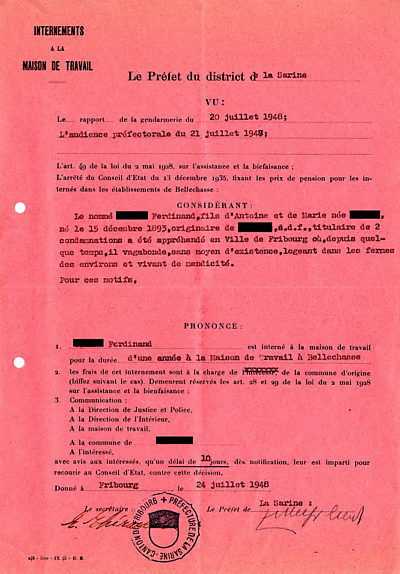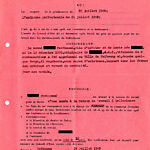Detention Order
 Préfecture de la Sarine, Canton de Fribourg: Internements à la maison de travail, Fribourg 1948
Préfecture de la Sarine, Canton de Fribourg: Internements à la maison de travail, Fribourg 1948 Under that law the Prefect is authorised «To incarcerate in a correctional labour facility for a term of from six months to one year persons who misuse the assistance that has been granted to them or who fail to comply with the directives of the Municipal or Welfare Council, persons who receive assistance from a welfare institution but refuse to accept such employment as is suited to their abilities and has been designated by the social care authorities, and persons who, after repeated warnings by the authority, solicit charity by engaging in house-to-house peddling despite receiving assistance form the Welfare Council.» (Art. 49)
Research questions
The IEC is interested, among other things, in ascertaining the manner in which laws were applied in actual practice. In this connection, it seeks to identify and understand the various cantonal procedures for the ordering of administrative detention.
In reconstructing the procedures used for applying the law, a number of specific questions must be answered, including:
- What proceedings were held and what was the reasoning behind the decisions reached?
- Who were the actors involved over the course of the proceedings and what legal opinions were consulted?
- Which groups of individuals were concerned?
- What means of appeal were available to persons who were incarcerated?
- Is it possible, in addition, to discern any continuity or (to the contrary) changes in the statutory regulations or in their practical application?
Use of sources
The source shown here was found in the case file for an individual who was held in incarceration in Bellechasse (FR). The facility where an individual was to be incarcerated received an incarceration order for each inmate and preserved a copy of the order in the inmate’s case file.
That order was sufficient for proceeding with incarceration. By comparing and studying orders of the same type researchers are able to distinguish the elements of such orders that were regularly repeated and possibly also to identify the specific factors that were considered necessary as grounds for incarceration. Is the circumstance that the individual concerned already had two criminal convictions on his record a decisive factor? Was the problem his public behaviour in the city? What types of behaviour are implied by the use of the terms “vagrancy” and “soliciting charity”? For what reason did the municipal police decide to issue an administrative detention order rather than seeking a criminal conviction?
Generally speaking, answers must be sought to the following fundamental questions: What were the factors that led to the decision to issue an administrative detention order? What were the legal bases for the order? What was the procedure for preparing and deciding on the order that led to incarceration? The source here shown does not provide sufficient information to answer these questions. For that reason, a number of such orders must be examined. It is also necessary to study documents that are of direct relevance to the order, but which were not preserved in the case files of individuals who were incarcerated in Bellechasse. The question that determines how researchers will proceed in this specific case is this: Is it still possible today to locate the police report filed on 20 July 1948, the transcript of the interrogation that was held on 21 July, or any other records that relate to the case and which are mentioned in the detention order?
M. Lavoyer/Translation
Source
Préfecture de la Sarine, Canton de Fribourg: Internements à la maison de travail, Fribourg 1948.
Signature: Staatsarchiv Freiburg (StAF): Bestand Bellechasse, Dossier A 6737.
Remarks
In order to protect the identity of the individual concerned by this order, some personal information has been redacted for publication purposes.
 previous source
previous source


